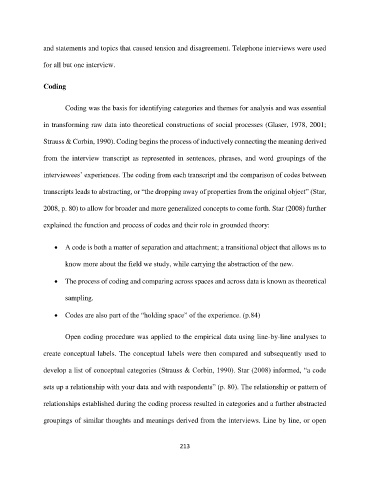Page 232 - Mike Ratner CC - WISR Complete Dissertation - v6
P. 232
and statements and topics that caused tension and disagreement. Telephone interviews were used
for all but one interview.
Coding
Coding was the basis for identifying categories and themes for analysis and was essential
in transforming raw data into theoretical constructions of social processes (Glaser, 1978, 2001;
Strauss & Corbin, 1990). Coding begins the process of inductively connecting the meaning derived
from the interview transcript as represented in sentences, phrases, and word groupings of the
interviewees’ experiences. The coding from each transcript and the comparison of codes between
transcripts leads to abstracting, or “the dropping away of properties from the original object” (Star,
2008, p. 80) to allow for broader and more generalized concepts to come forth. Star (2008) further
explained the function and process of codes and their role in grounded theory:
• A code is both a matter of separation and attachment; a transitional object that allows us to
know more about the field we study, while carrying the abstraction of the new.
• The process of coding and comparing across spaces and across data is known as theoretical
sampling.
• Codes are also part of the “holding space” of the experience. (p.84)
Open coding procedure was applied to the empirical data using line-by-line analyses to
create conceptual labels. The conceptual labels were then compared and subsequently used to
develop a list of conceptual categories (Strauss & Corbin, 1990). Star (2008) informed, “a code
sets up a relationship with your data and with respondents” (p. 80). The relationship or pattern of
relationships established during the coding process resulted in categories and a further abstracted
groupings of similar thoughts and meanings derived from the interviews. Line by line, or open
213

